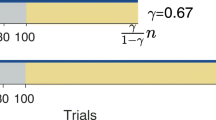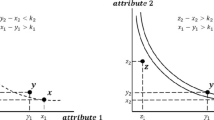Abstract
We propose a descriptive version of the classical multi-attribute utility model; to that end, we add a new parameter, momentary salience, to the customary formulation. The addition of this parameter allows the theory to accommodate changes in the decision maker’s mood and circumstances, as the saliencies of anticipated consequences are driven by concerns of the moment. By allowing for the number of consequences given attention at the moment of decision to vary, the new model mutes the criticism that SEU models call for an omniscient decision maker. Use of the model is illustrated with a large-scale longitudinal study showing that adolescent smokers have higher utility for smoking than nonsmokers. We also propose to use the model hierarchically to describe everyday decisions that people deal with repeatedly. Big decisions, which set policy, guide a host of nested little decisions, which in turn lead to action. For a little decision, one of the options will be consistent with the policy, and will inherit its high utility. Accordingly, most little decisions will be made quickly and will follow the policy. However, people do sometimes decide to violate their own policies, and we describe how these lapses can lead to collapse of the policy.
Similar content being viewed by others
References
Ajzen I. (1991) The theory of planned behavior. Organizational Behavior and Human Decision Processes, 50: 179–211
Anderson N.H., Shanteau J.C. (1970) Information integration in risky decision making. Journal of Experimental Psychology, 84: 441–451
Busemeyer J.R., Townsend J.T. (1993) Decision field theory: A dynamic-cognitive approach to decision making in an uncertain environment. Psychological Review, 100: 432–459
Chapman G.B., Niedermayer L.Y. (2001) What counts as a decision? Predictors of perceived decision making. Psychonomic Bulletin & Review, 8: 615–621
Coombs C.H., Bezembinder T.G., Goode F.M. (1967) Testing expectation theories of decision making without measuring utility or subjective probability. Journal of Mathematical Psychology, 4: 72–103
Cosmides L., Tooby J. (1994) Better than rational: Evolutionary psychology and the invisible hand. American Economic Review (Papers and Proceedings), 84: 327–332
Darwin C.R. (1881) The formation of vegetable mould through the action of worms, with observations on their habits. John Murray, London
Devine C.M., Nelson J.A., Chin N., Dozier A., Fernandez I.D. (2007) “Pizza is cheaper than salad”: Assessing workers’ views for an environmental food intervention. Obesity, 15: 57S–68S
Dill L.M., Fraser A.H.G. (1997) The worm re-turns: Hiding behavior of a tube-dwelling marine polychaete, Serpula vermicularis. Behavior Ecology, 8: 186–193
Edwards W. (1954) The theory of decision making. Psychological Bulletin, 51: 380–417
Edwards W. (1961) Behavioral decision theory. Annual Review of Psychology, 12: 473–498
Edwards W. (1962) Subjective probabilities inferred from decisions. Psychological Review, 69: 109–135
Edwards W. (1973) Divide and conquer: How to use likelihood and value judgments in decision making. In: Miles R.F. (eds) Systems concepts: Lectures on contemporary approaches to systems. Wiley, New York, pp 87–110
Edwards W., Barron F.H. (1994) SMARTS and SMARTER: Improved simple methods for multiattribute utility measurement. Organizational Behavior and Human Decision Processes, 60: 306–325
Edwards W., Fasolo B. (2001) Decision technology. Annual Review of Psychology, 52: 581–606
Garcia J., Hankins W.G., Rusiniak K.W. (1974) Behavioral regulation of the milieu interne in man and rat. Science, 185: 824–831
Gigerenzer G., Todd P.M., & the ABC Research Group (1999). Simple heuristics that make us smart. New York: Oxford University Press.
Hill D., Weiss D.J., Walker D.L., Jolley D. (1988) Long-term evaluation of controlled smoking as a treatment outcome. British Journal of Addiction, 83: 203–207
Hoffman P. (1960) The paramorphic representation of clinical judgment. Psychological Bulletin, 57: 116–131
Howard R. (1992) In praise of the old time religion. In: Edwards W.(eds) Utility theories: Measurements and applications. Kluwer, Boston, pp 27–56
Janis I.L., Mann L. (1977) Decision making. The Free Press, New York
Jeffery R.W., Wing R.R., Thorson C., Burton L.R., Raether C., Harvey J., Mullen M. (1993) Strengthening behavioral interventions for weight loss: A randomized trial of food provision and monetary incentives. Journal of Consulting and Clinical Psychology, 61: 1038–1045
Kahneman D., Tversky A. (1984) Choices, values, and frames. American Psychologist, 39: 341–350
Keeney R.L., Raiffa H. (1976) Decisions with multiple objectives. Wiley, New York
Loewenstein G. (2005) Hot-cold empathy gaps and medical decision making. Health Psychology, 24: S49–S56
Loewenstein, G., Read, D., Baumeister, R.F. (eds) (2003) Time and decision. Russell Sage Foundation, New York
Luce R.D. (1992) Where does subjective expected utility fail descriptively?. Journal of Risk and Uncertainty, 5: 5–27
Maddock J. (2004) The relationship between obesity and the prevalence of fast food restaurants: State-level analysis. American Journal of Health Promotion, 19: 137–143
Mann T., Tomiyama A.J., Westling E., Lew A.-M., Samuels B., Chatman J. (2007) Medicare’s search for effective obesity treatments. American Psychologist, 62: 220–233
Marlatt, G.A., Donovan, D.M. (eds) (2005) Relapse prevention (2nd ed). Guilford Press, New York
Mellers B.A., McGraw A.P. (2001) Anticipated emotions as guides to choice. Current Directions in Psychological Science, 10: 210–214
Mellers B., Schwartz A., Ritov I. (1999) Emotion-based choice. Journal of Experimental Psychology: General, 128: 332–345
Mosteller F., Nogee P. (1951) An experimental measure of utility. Journal of Political Economy, 59: 371–404
Pennings T.J. (2003) Do dogs know calculus?. College Mathematics Journal, 34: 178–182
Polivy J., Herman C.P. (2002) If at first you don’t succeed: False hopes of self-change. American Psychologist, 57: 677–689
Read D., van Leeuwen B. (1998) Predicting hunger: The effects of appetite and delay on choice. Organizational Behavior and Human Decision Processes, 76: 189–205
Reagan R., Mosteller F., Youtz C. (1989) Quantitative meanings of verbal probability expressions. Journal of Applied Psychology, 74: 433–442
Rosenstock J.M. (1974) Historical origins of the health belief model. Health Education Monographs, 2: 1–9
Rothman A.J. (2000) Toward a theory-based analysis of behavior maintenance. Health Psychology, 19: 1–6
Sanfey A.G., Loewenstein G., McClure S.M., Cohen J.D. (2006) Neuroeconomics: Cross-currents in research on decision-making. Trends in Cognitive Science, 10: 108–116
Shepard R.N. (1964) On subjectively optimum selection among multiattribute alternatives. In: Shelly M.W., Bryan G.L.(eds) Human judgments and optimality. Wiley, New York, pp 257–281
Shiffman S. (2006) Reflections on smoking relapse research. Drug and Alcohol Review, 25: 15–20
Simon H. (1982) Models of bounded rationality. MIT Press, Cambridge, MA
Stone A.A., Shiffman S. (1994) Ecological momentary assessment (EMA) in behavioral medicine. Annals of Behavioral Medicine, 16: 199–202
Thaler R.H. (1985) Mental accounting and consumer choice. Marketing Science, 4: 199–214
von Winterfeldt D., Edwards W. (1986) Decision analysis and behavioral research. Cambridge University Press, New York
Wansink B., Sobal J. (2007) Mindless eating: The 200 daily food decisions we overlook. Environment and Behavior, 39: 106–123
Weinstein N.D. (1993) Testing four competing theories of health-protective behavior. Health Psychology, 12: 324–333
Weiss D.J. (2006) Analysis of variance and functional measurement: A practical guide. Oxford University Press, NY
Weiss, J.W., Weiss, D.J. (eds) (2009) A science of decision making: The legacy of Ward Edwards. Oxford University Press, New York
Weiss J.W., Edwards W., Mouttapa M. (2009) The puzzle of adolescent substance initiation. In: Weiss J.W., Weiss D.J. (eds) A science of decision making: The legacy of Ward Edwards. Oxford University Press, New York, pp 439–450
Author information
Authors and Affiliations
Corresponding author
Additional information
Ward Edwards died in 2005. Although this manuscript was written several years after his passing, he participated in the development of several of the key ideas, especially the notion of option packaging. The new parameter, momentary salience, was introduced to resolve the disconnect between laboratory studies of decision making, in which the options and their consequences are fully laid out before the subject, and everyday decisions, in which the decision maker usually has to determine what the reasonable options are before choosing among them. For further discussion of our collaborative efforts, see the introductions in Weiss and Weiss (2009).
Rights and permissions
About this article
Cite this article
Weiss, J.W., Weiss, D.J. & Edwards, W. A descriptive multi-attribute utility model for everyday decisions. Theory Decis 68, 101–114 (2010). https://doi.org/10.1007/s11238-009-9155-1
Received:
Accepted:
Published:
Issue Date:
DOI: https://doi.org/10.1007/s11238-009-9155-1




